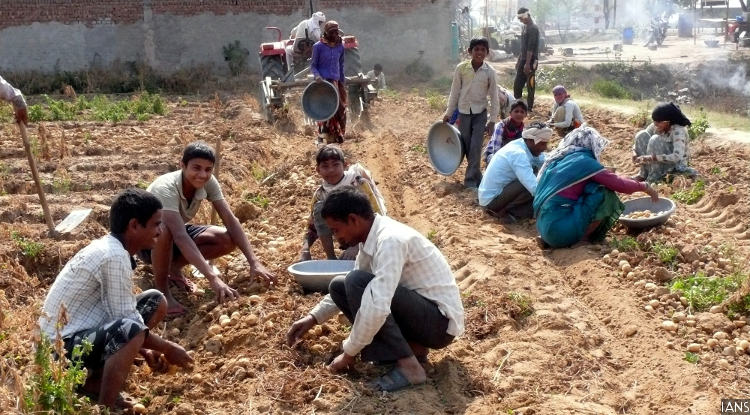Why UP CM's Plan To Double Farm Income By 2022 Is Improbable

Farmer pick potatoes from a field near Mathura, Uttar Pradesh. CM Yogi Adityanath aims to double farmers' income over the next five years, but even if that unlikely proposition were to fructify, the UP farmer's income would still be lower than the minimum wage for skilled agriculture labourers in 2017.
On November 11, 2017, chief minister of Uttar Pradesh Yogi Adityanath constituted a Farmers' Welfare Commission to double the income of farmers by 2022.
Assuming CM Adityanath's proposal succeeds--an unlikely proposition, given that the average Indian farmer's income, after adjusting for inflation, rose 5% per year over a decade to 2013--a FactChecker analysis of government data reveals that farmers' incomes would still be lower than the minimum wage for skilled agriculture labourers in 2017.
The proposition of doubling farmers' incomes was first announced by Finance Minister Arun Jaitley during his budget speech on February 29, 2016. After adjusting for inflation, an Indian farmer's income effectively rose 5% per year over a decade (2003-2013), so Jaitley's declaration was improbable, IndiaSpend reported on March 30, 2016.
The average monthly income of a UP farm household is Rs 4,923, of which Rs 2,855 is from cultivation; the nationwide average is Rs 6,426. The remaining income is from non-farm businesses, farming of animals and wages from other work, according to the 2013 situation assessment survey of agricultural households by the National Sample Survey Office (NSSO), the latest available data.
UP has 18 million agricultural households which account for 20% of those across India. The income from cultivation of a UP farm household is 92% as much as the national average of Rs 3.081, data further reveal.
If Adityanath succeeds, the average income of a UP farm household only from cultivation would be Rs 5,710 (Rs 190/day) by 2022. However, if we include a UP farm household's income from all sources (such as cultivation and non-farm business) and double it by 2022, it would be Rs 9,846 (Rs 328/day).
To put these data in perspective, the minimum wage for skilled workers in agriculture in rural areas is Rs 342 (Rs 10,260) and for semi-skilled workers Rs 315 (Rs 9,450), according to this April 2017 notification from the central labour commissioner.
Effectively, it would mean that a doubling of farmers' incomes would still lead to an income lower or, at most, equal to minimum wages prescribed for skilled agriculture labourers in 2017.
As much as 80% of sown area in UP is irrigated, just behind Punjab (98%) and Haryana (90%), according to latest government data. Despite this, UP farm households are among the poorest in the country, with 66.8% of households being below the poverty line, third highest in the country behind Bihar (71.8%) and Uttarakhand (66.9%), according to this 2015 analysis of government data.
Nearly 91% of farmers in UP are small and marginal farmers (having land holdings less than 2 hectares) and 8.1% of agricultural households in UP hold the Antyodaya card--issued to ultra-poor households who have an income less than Rs 250 per capita per month--followed by Karnataka (5.8%) and Jharkhand (5.8%).
"Doubling of real incomes would be "a miracle of miracles", as it would imply a compound growth rate of 12% per annum," Ashok Gulati, former chairman of the Commission for Agricultural Costs and Prices, and Shweta Saini, consultant, Indian Council for Research on International Economic Relations, wrote in the Indian Express on March 28, 2016.
In September 2017, the ministry of agriculture released a seven-step strategy to double the income of farmers by 2022. These steps include an increase in production, effective use of input cost, reduction of post-harvest losses, value addition through food processing, reforms in agriculture marketing, increasing crop insurance and focusing on allied activities such as horticulture, beekeeping, poultry farming, etc.
The multiplicity of taxes under Agriculture Produce and Marketing Committee laws in various states have undermined interests of farmers and benefitted middlemen and only 19 million--or 15%--Indian farmers benefitted from crop insurance schemes announced by the government in 2014-15, IndiaSpend reported on March 30, 2016.
(Saha is an MA Gender and Development graduate from the Institute of Development Studies, University of Sussex.)


